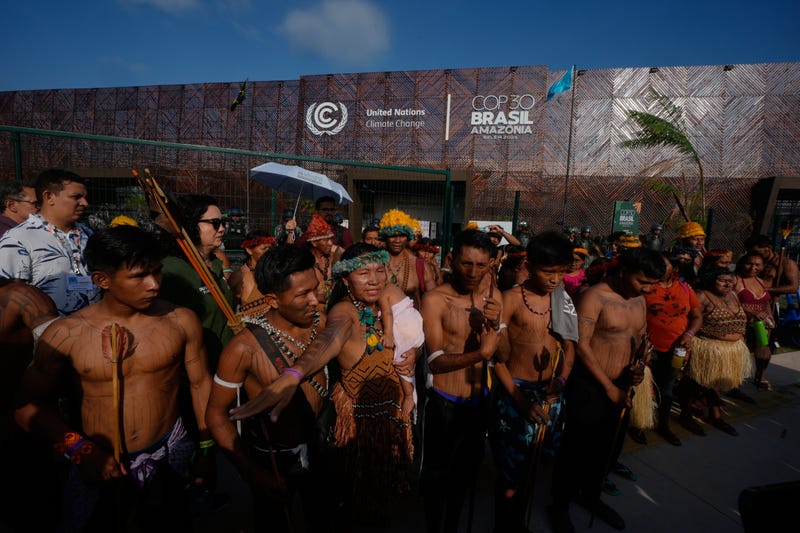
BELEM, Brazil (AP) — About 100 Indigenous protesters blocked the main entrance to the United Nations climate conference on the edge of the Brazilian Amazon for 90 minutes on Friday in a peaceful standoff that ended after a lengthy discussion with the climate talks president, who cradled a protester's baby during the talks.
Brazilian military personnel kept demonstrators from entering the site hosting COP30 meetings in Belem, but there appeared to be no physical altercations. The protesters, most in traditional Indigenous garb, formed a human chain around the entrance to block people from entering as the day's meetings began. Other groups of activists formed a secondary chain around them.
“No one enters, no one leaves,” was one of the main chants of the demonstration.
It was the second time in four days that protesters disrupted climate talks that organizers have promoted as empowering and celebrating native peoples.
Members of the Munduruku Indigenous group led the demonstration that blocked the main entrance, demanding a meeting with Brazilian President Luiz Inácio Lula da Silva.
“President Lula, we are here in front of COP because we want you to listen to us. We refuse to be sacrificed for agribusiness,'' protesters said in a written statement in Portuguese released by the Munduruku Ipereg Ayu Movement. "Our forest is not for sale. We are the ones who protect the climate, and the Amazon cannot continue to be destroyed to enrich large corporations.”
Munduruku leaders had a series of demands for Brazil. They included revoking plans for commercial development of rivers, canceling a grain railway project that has raised fears of deforestation and clearer demarcations of Indigenous territories. They also want a rejection of deforestation carbon credits.
During the 90 minutes of blockage, conference participants were rerouted and delegates entered the venue through another door. U.N. staff rushed to move metal detectors to the side entrance as hundreds of people formed long lines. The protest at the front of the venue began at around 7:30 a.m., with the main entrance blocked about 30 minutes later.
Conference president André Corrêa do Lago, a veteran Brazilian diplomat, met with the group as they blocked the entrance. He cradled a protester's baby in his arms as he talked, smiling and nodding. After a prolonged discussion, do Lago and the protesters moved away from the entrance together. The entrance opened at 9:37 a.m.
The United Nations Framework Convention on Climate Change told conference participants “there is no danger” from what they called a peaceful demonstration.
Paolo Destilo, with the environmental group Debt for Climate, joined the human chain encircling the protesters, saying he wanted to give Indigenous communities a chance to have their voices heard.
“This is worth any delays to the conference,” he said, adding: “If this is really to be Indigenous peoples’ COP, like officials keep saying, these types of demonstrations should be welcomed at COP30.”
"We should look at this as a message and signal from Indigenous people, who have not seen any progress over the past 33 years of COP, that all these conversations have not led to actions,” veteran anti-fossil fuel activist Harjeet Singh said. “They are the custodians of biodiversity and climate and clearly, they are not satisfied with how this process is doing.”
“We share the frustrations that the negotiations have not delivered,” Singh said. “And the only way to address these shared frustrations is by actually addressing the climate crisis.”
The demonstration comes after an incident Tuesday night in which Indigenous demonstrators rushed the entrance of the main venue, clashing with security and leaving two guards with minor injuries.
Demonstrations appeared to be ramping up heading into the weekend. Saturday at the end of the conference's first week is traditionally the day of the biggest protests during United Nations climate talks.
___ The Associated Press’ climate and environmental coverage receives financial support from multiple private foundations. AP is solely responsible for all content. Find AP’s standards for working with philanthropies, a list of supporters and funded coverage areas at AP.org. ___
This story was produced as part of the 2025 Climate Change Media Partnership, a journalism fellowship organized by Internews’ Earth Journalism Network and the Stanley Center for Peace and Security.